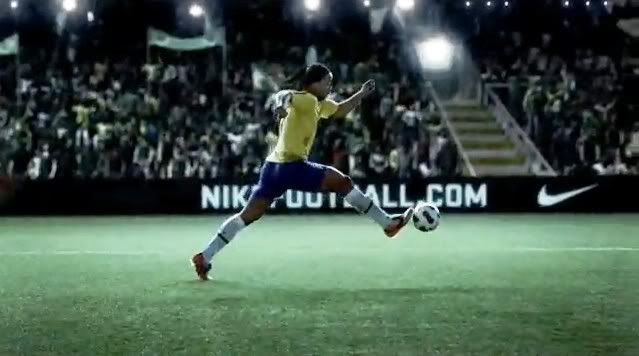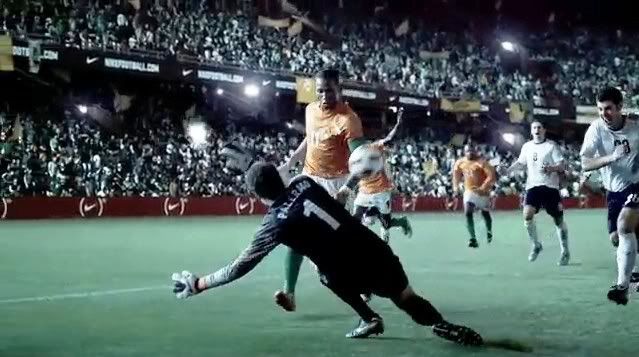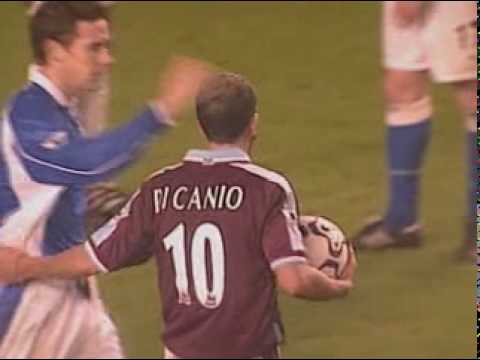Essay Question: In the 20th
century sport undergoes three major developments: it becomes a global activity;
it is increasingly oriented towards spectatorship and entertainment; and it
moves away from the ideals of Greek athletics, and is integrated into the
contemporary, media-driven culture of the spectacle. Using this clip as the basis of your
analysis and argument, explain and show how these developments have influenced
and changed contemporary sport.
In the late nineteenth century, sport was a communal
exercise. People, on a local scale,
would participate in sporting activities where spectators were frowned upon and
there was little involvement from the fields of media or business (Schirato
97). However, the twentieth century saw sport make a transition away from these
ideals. This essay will examine a video advertisement – “NIKEFOOTBALL WRITE THE FUTURE - FULLLENGTH VERSION” (Nike’s Write the Future) – to argue that it is a
perfect embodiment of how sport, in particular football, has significantly
moved away from its amateur days. This argument will be reinforced through an
analysis of the video, where sport is portrayed as a global enterprise that has
been inserted into the logics of the media and professionalism. The video also
contains numerous examples of fans’ reactions and fast-paced montages that
reflect the attention-seeking qualities of the spectacle.
Globalization
is essentially the “growing interconnectedness” of the world where the physical
boundaries of nation-states are becoming increasingly insignificant (Held and
McGrew 1). In Write the Future, Nike is able to connect the world and attract a
global audience because the video features footballers from various countries
and continents such as Africa, South America and Europe.
All the featured players
have competed in previous FIFA World Cups and Europe’s
top football leagues. Because these competitions are televised around the
world, this video successfully appeals to a wide demographic of potential
consumers.
 |
| Ronaldinho |
The
process of globalization has been aided by technological advances that have led
to the compression of time and space (Eitzen and Baca Zinn 1). This has
resulted in what Marshall McLuhan defines as a “global village” where everyone
can experience the same events simultaneously (Kellner 118). In the sequence of
shots involving Brazilian footballer Ronaldinho, he tricks his opponents with
some fancy footwork. This event continues in the very next shot, but Ronaldinho
is now being mediated through the video sharing website YouTube and millions of viewers “Like” the video. Relating to this
is Anderson’s idea of “imagined communities”
where geographical boundaries are overcome as people “act as members of a
community” through cultural representations (Schirato 88). Following
Ronaldinho’s performance is a montage of user-generated videos where different
people in different locations all copy Ronaldinho. The internet
allows us to overcome physical distance, share our own imitations of an event,
and interact over a common occurrence. Ronaldinho is shown to have a global fan
base that, although they have never met before, is bounded together by the same
attachment to a player, or consumption of the same product.
Globalization
can be thought of as a process of “Westernization” where Western countries
impose their ideologies on the rest of the world (Houlihan 347; Giddens 19).
Guy Debord, in “Society of the Spectacle,” argues that the spectacle
“epitomizes the prevailing model of social life” (75). In other
words, the spectacle exemplifies the dominant ideas and beliefs that circulate
in society.
Nike is an American based multi-national corporation that operates under a
capitalist model, and Kellner argues that corporations are willing to pay
“top dollars” to get their products associated with sports “heroes” who
function as “embodiments … of the good life,” (6). Nike’s choice of footballers is also
due to the fact that the players in question have all had success at the
highest level, either for their club or country, and at the time of production
were among the world’s highest paid footballers. By selecting multi-million
dollar earners, Nike reinforces what Kellner refers to as the “capitalist
ethic” (65). That is, success and money go hand in hand.
A
globalization of culture also takes place as all players adhere to the same
style of football. The recognitions explained above depend on cultural
literacy, that is, the ability to understand the so called “meaning systems”
within cultural fields (Schirato et al. 190). Viewers who are unaware that the
sponsored players featured in this video are global football icons will not be
swayed by Nike to consume their products. Right from the beginning Nike, in
order to get the attention of these viewers, presents a fast-paced and
attack-orientated style of football. Côte d'Ivoire’s Didier Drogba is the
first footballer featured in this video and he demonstrates this energetic
style of football in the process of outwitting his opponents.
 |
| Drogba |
In the
early twentieth century, the “sport-media nexus” was established where
individuals could get closer to sporting events, for example, through accounts
in the news media (Schirato 84; Guttmann 85). In other words, contemporary
sport differs from earlier sport because it has become immersed into the logics
of the media. The
Drogba sequence illustrates this connection. Nowadays, sport stadiums are
designed to support the demands of advertisers, cameras and spectators, with
the purpose of encouraging consumption (Schirato 122). Nike’s fictional
football event takes place inside a multi-million dollar stadium and as Drogba
controls the ball, Nike advertising billboards surround a crowd of thousands of
fans. Photographers and cameramen track Drogba’s movements and, in their
purpose-built environments, commentators scream into their microphones and journalists
wait at their laptops, getting ready to write their reports on the action that
unfolds.
Contemporary sport also has
a strong emphasis on spectators. Schirato observes that the media treats fans
as commodities, in that their “passionate” attachment can help encourage
consumption (90). Some of the fans within the stadium display banners in order
to signal their attachment to Drogba. In a swift montage of shots, Côte d'Ivoire fans line the streets and while a
fireworks display takes place they respond emotionally by cheering, dancing,
playing drums and waving flags. Essentially, Nike associates its brand with a
passionate fan base by creating a party-like atmosphere in the hope of selling its
products. This rapid sequence of images also gives us very little time to
contemplate what we are seeing.
 |
| Cannavaro |
Attention
management is “all-important” in the spectacle and this is achieved by making
each successive event “more dramatic and intense” than previous ones (Schirato
et al. 150). After Drogba chips the ball over the goalkeeper, we start to
assume that a goal will be scored. In other words, the spectacle is coming to
an end and our attention begins to wander. However, Italy’s
Fabio Cannavaro performs a bicycle kick in slow motion to successfully defend
Drogba’s shot. The viewer is then taken away from the football pitch to a
theatrical celebration in honour of Cannavaro. Ladies dance in sparkling blue
outfits and countless, multi-coloured stage lights accompany upbeat music.
Write the Future is sustaining its dramatic element in order to hold our
attention. Furthermore, sport has undergone a transition over time. It is not
necessarily valued by the action that takes place on the field but is more
judged by the entertainment factor that it brings to spectators.
The
significance of spectators in contemporary sport is further portrayed through England’s Wayne Rooney. A close-up camera shot reveals a
fearful look in Rooney’s eyes after his pass is intercepted. It would go
against the logic of the spectacle if he was shown chasing after the ball. This
would not be very exciting compared to the earlier examples of Cannavaro and
Drogba. Instead, a hysterical collection of premonitions is given from Rooney’s
perspective. Hysteria is another quality of the spectacle, and can be defined
as an “uncontrollable state of mind brought about by panic and/or an
overreaction to events” (Schirato et al. 151). Within Rooney’s mind, street
riots take place and newspapers are published with headlines implying his
demise. In essence, Rooney is deeply concerned about how his life will
eventuate. Although Rooney wants to perform for himself and his team, at the
forefront of his mind is how the English news media and football fans will
react unless he gets the ball back.
 |
| Rooney |
When
Rooney does regain control of the football, a fast-paced montage exemplifies
Debord’s notion that, in the world of the spectacle, “truth is a moment of
falsehood” (76). In other words, the spectacle involves constant hyperbole in creating
extraordinary scenarios. Rooney has just performed a standardized action on the
football field, but he constructs a world where numerous newborn babies are
named after him, the financial markets climb, and he is knighted by the British
Queen. Put simply, Rooney creates a more positive outlook and exaggerates how
English society will react. This
example embodies the idea that the spectacle involves a saturation of
exaggerated images with the hope of encouraging consumption.
In
conclusion, Nike’s Write the Future is a great example of how sport has become
immersed into the logics of the media and the spectacle. Technological advances
have led to a process of globalization where culture is being homogenized,
multinational corporations impose capitalist ideologies, and people from
disparate locations experience the same events at the same time. Actual action
on the football pitch makes up less than half of this video’s running time, therefore
emphasizing the spectator and entertainment orientated nature of present-day
sports events. Nike has also given its footballers exaggerated examples of
success and, fittingly, the video concludes with another fast-paced montage
featuring another global football icon, Portugal’s Cristiano Ronaldo, who has
just taken a penalty kick. However we are left uncertain as to if Ronaldo
scores. Instead, the video ends with the phrase “Write the Future,” implying
that if we consume Nike’s commodities – whether it is their sponsored
footballers, the fans’ passion, or physical sports gear and equipment – we can
control our own destiny.
References
Debord,
Guy. “Separation Perfected.” The Society
of the Spectacle. Trans. Donald Nicholson Smith. New York: Zone Books, 1995. 11-24. Rpt. in MDIA 203: Visual Culture Course Reader. Comp.
Minette Hillyer. Wellington: Victoria
University,
2011. 74-81. Print.
Eitzen,
Stanley and Bacca Zinn, Maxine. “Introduction.” Globalization: The Transformation of Social Worlds. Eds. Stanley
Eitzen and Maxine Bacca Zinn. California:
Thompson Wadsworth,
2008. 1-14. Print.
Guttmann, Allan. Sports Spectators. New York: Columbia
University
Press, 1986. Print.
Held,
David and McGrew, Anthony. Globalization/Anti-Globalization.
Cambridge:
Polity Press, 2002. Print.
Houlihan,
Barrie. “Sport and Globalisation.” Sport
and Society: A Student Introduction. Ed. Barrie Houlihan. London: SAGE Publications Ltd, 2003. 345-363.
Print.
Keller,
Douglas. Media Spectacle. London: Routledge, 2003.
Print.
Kellner,
Douglas. “Media Spectacle, Presidential Politics, and the Transformation of
Journalism.” The Routledge Companion to
News and Journalism. Ed. Stuart Allan. Abingdon: Routledge, 2012. 116-126.
Print.
NikeFootball. “NIKE FOOTBALL WRITE THE FUTURE - FULL LENGTH VERSION” 21 Dec. 2010. YouTube. Web Video. 17 Sep. 2012. <http://www.youtube.com/watch?v=dBZtHAVvslQ>
Schirato,
Tony, Angi Buettner, Thierry Jutel and Geoff Stahl. Understanding Media Studies. Melbourne:
Oxford
University
Press, 2010. Print.
Schirato,
Tony. Understanding Sports Culture. London: SAGE
Publications, 2007. Print.
![[An image showing Rugby School]](http://www.crosbyheritage.co.uk/images/photos/dad%20rugby%20%20rugby%20school%20008.jpg)

